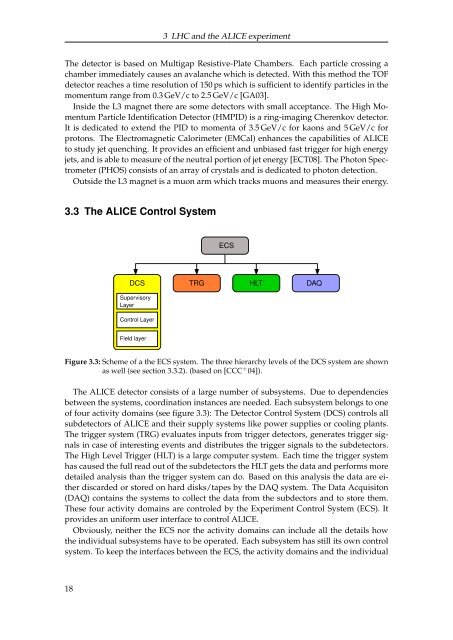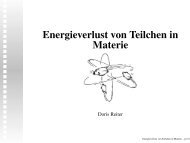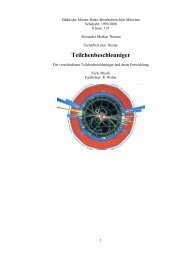The FEE Server Control Engine of the ALICE-TRD - Westfälische ...
The FEE Server Control Engine of the ALICE-TRD - Westfälische ...
The FEE Server Control Engine of the ALICE-TRD - Westfälische ...
You also want an ePaper? Increase the reach of your titles
YUMPU automatically turns print PDFs into web optimized ePapers that Google loves.
3 LHC and <strong>the</strong> <strong>ALICE</strong> experiment<br />
<strong>The</strong> detector is based on Multigap Resistive-Plate Chambers. Each particle crossing a<br />
chamber immediately causes an avalanche which is detected. With this method <strong>the</strong> TOF<br />
detector reaches a time resolution <strong>of</strong> 150 ps which is sufficient to identify particles in <strong>the</strong><br />
momentum range from 0.3 GeV/c to 2.5 GeV/c [GA03].<br />
Inside <strong>the</strong> L3 magnet <strong>the</strong>re are some detectors with small acceptance. <strong>The</strong> High Momentum<br />
Particle Identification Detector (HMPID) is a ring-imaging Cherenkov detector.<br />
It is dedicated to extend <strong>the</strong> PID to momenta <strong>of</strong> 3.5 GeV/c for kaons and 5 GeV/c for<br />
protons. <strong>The</strong> Electromagnetic Calorimeter (EMCal) enhances <strong>the</strong> capabilities <strong>of</strong> <strong>ALICE</strong><br />
to study jet quenching. It provides an efficient and unbiased fast trigger for high energy<br />
jets, and is able to measure <strong>of</strong> <strong>the</strong> neutral portion <strong>of</strong> jet energy [ECT08]. <strong>The</strong> Photon Spectrometer<br />
(PHOS) consists <strong>of</strong> an array <strong>of</strong> crystals and is dedicated to photon detection.<br />
Outside <strong>the</strong> L3 magnet is a muon arm which tracks muons and measures <strong>the</strong>ir energy.<br />
3.3 <strong>The</strong> <strong>ALICE</strong> <strong>Control</strong> System<br />
DCS TRG HLT<br />
DAQ<br />
Supervisory<br />
Layer<br />
<strong>Control</strong> Layer<br />
Field layer<br />
ECS<br />
Figure 3.3: Scheme <strong>of</strong> a <strong>the</strong> ECS system. <strong>The</strong> three hierarchy levels <strong>of</strong> <strong>the</strong> DCS system are shown<br />
as well (see section 3.3.2). (based on [CCC + 04]).<br />
<strong>The</strong> <strong>ALICE</strong> detector consists <strong>of</strong> a large number <strong>of</strong> subsystems. Due to dependencies<br />
between <strong>the</strong> systems, coordination instances are needed. Each subsystem belongs to one<br />
<strong>of</strong> four activity domains (see figure 3.3): <strong>The</strong> Detector <strong>Control</strong> System (DCS) controls all<br />
subdetectors <strong>of</strong> <strong>ALICE</strong> and <strong>the</strong>ir supply systems like power supplies or cooling plants.<br />
<strong>The</strong> trigger system (TRG) evaluates inputs from trigger detectors, generates trigger signals<br />
in case <strong>of</strong> interesting events and distributes <strong>the</strong> trigger signals to <strong>the</strong> subdetectors.<br />
<strong>The</strong> High Level Trigger (HLT) is a large computer system. Each time <strong>the</strong> trigger system<br />
has caused <strong>the</strong> full read out <strong>of</strong> <strong>the</strong> subdetectors <strong>the</strong> HLT gets <strong>the</strong> data and performs more<br />
detailed analysis than <strong>the</strong> trigger system can do. Based on this analysis <strong>the</strong> data are ei<strong>the</strong>r<br />
discarded or stored on hard disks/tapes by <strong>the</strong> DAQ system. <strong>The</strong> Data Acquisiton<br />
(DAQ) contains <strong>the</strong> systems to collect <strong>the</strong> data from <strong>the</strong> subdectors and to store <strong>the</strong>m.<br />
<strong>The</strong>se four activity domains are controled by <strong>the</strong> Experiment <strong>Control</strong> System (ECS). It<br />
provides an uniform user interface to control <strong>ALICE</strong>.<br />
Obviously, nei<strong>the</strong>r <strong>the</strong> ECS nor <strong>the</strong> activity domains can include all <strong>the</strong> details how<br />
<strong>the</strong> individual subsystems have to be operated. Each subsystem has still its own control<br />
system. To keep <strong>the</strong> interfaces between <strong>the</strong> ECS, <strong>the</strong> activity domains and <strong>the</strong> individual<br />
18







